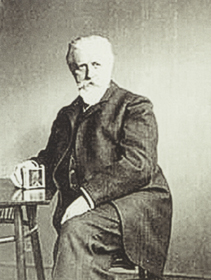Ottomar Anschütz facts for kids
Quick facts for kids
Ottomar Anschütz
|
|
|---|---|
 |
|
| Born | 16 May 1846 Lissa, Prussia
|
| Died | 20 May 1907 (aged 61) |
| Nationality | German |
| Known for | Photography |
Ottomar Anschütz (born May 16, 1846, in Lissa – died May 30, 1907, in Berlin) was a German inventor and photographer. He was also a pioneer in chronophotography, which is like taking many quick photos to show movement.
Contents
A Photographer's Journey
Ottomar Anschütz learned photography from 1864 to 1868. He studied with famous photographers like Ferdinand Beyrich and Franz Hanfstaengl. In 1867, he became known for a photo of John of Saxony on horseback. After his studies, he took over his father's business in Lissa. He mainly worked as a portrait photographer, taking pictures of people. He also did decorative painting.
Capturing Fast Moments
Anschütz made his first "instantaneous photographs" in 1881. These were photos taken very quickly. In 1882, he created a special portable camera. This camera had a shutter that could open and close in just 1/1000 of a second. This was incredibly fast for the time!
He became famous for his sharp photos of military shows in Breslau in 1882. He gained even more fame with pictures of flying storks in 1884. He showed his amazing work at exhibitions in Berlin and Düsseldorf.
Inventing a New Shutter
In 1885, Anschütz started working on chronophotography. This led to his very successful Electrotachyscope. He patented a special shutter on November 11, 1888. It was called the Brennebenen-Verschluss. This shutter could capture images in just 76 millionths of a second. It was used in cameras by C.P. Goerz & Co for nearly 30 years. Anschütz also designed at least three camera models for this company. In 1888, he moved to Berlin and opened his own photography studio.
Awards and Recognition
Ottomar Anschütz received several awards for his photography:
- Bronze medal at the 1883 photography exhibition in Brussels.
- Vermeille medal from the Photografischen Gesellschaft in Wien in 1887. This was for his series of quick, systematic photographs.
- Silver medal at the 1889 Photographischen Jubiläumsausstellung in Berlin.
- Honorary diploma at the July 1891 photography exhibition in Brussels.
- Gold medal at the 1900 Photographischen Ausstellung in Berlin.
Early Motion Pictures
Anschütz began making chronophotographs of horses in 1885. He used 12 cameras for this project. The Prussian Minister of Culture supported his work. In 1886, he continued studying horses in motion. He used 24 cameras for the Ministry of War. This resulted in over one hundred series of sequential photos.
The Electrotachyscope
Anschütz's pictures were much clearer than those by other pioneers like Eadweard Muybridge and Étienne-Jules Marey. Their photos often looked like silhouettes. Anschütz's images showed much more detail.
In 1886, Anschütz invented the Electrotachyscope. This was an early device that showed short motion picture loops. It used 24 glass plate photographs. These were placed on a large rotating wheel, about 1.5 meters wide. People would hand-crank the wheel to make it spin at about 30 frames per second. Each image was lit up by a sparking light. The pictures were shown on a small window in a dark room. Up to seven people could watch at a time.
Public Shows and Impact
Different versions of the Electrotachyscope were shown at many international exhibitions. They appeared at fairs, conventions, and arcades from 1887 to at least 1894. From 1890, Anschütz also showed a coin-operated version. This one was cylindrical and had six small viewing screens.
Starting in 1891, about 152 of a coin-operated peep-box Electrotachyscope were made. These were built by Siemens & Halske in Berlin and sold worldwide. They were used in public arcades. One was shown at the International Electrotechnical Exhibition in Frankfurt. Nearly 34,000 people paid to see it in Berlin in the summer of 1892. Others saw it in London or at the 1893 Chicago World's Fair.
On November 25, 1894, Anschütz introduced an Electrotachyscope projector. This machine could project images onto a large screen, 6x8 meters in size, in Berlin. From February 22 to March 30, 1895, about 7,000 paying customers came to see a 1.5-hour show. It featured about 40 different scenes. The shows took place in a 300-seat hall in the old Reichstag building in Berlin.
Lasting Influence
Anschütz's 1884 photographs of storks inspired aviation pioneer Otto Lilienthal. Lilienthal used these images to help design his experimental gliders in the late 1880s.
Anschütz's many international motion picture exhibitions likely inspired other pioneers in the history of film technology. For example, Georges Demenÿ probably saw Anschütz's "Sprechende Porträts" before creating his Phonoscope in 1891. It's also thought that Thomas Edison or his team might have seen the Electrotachyscope. This could have influenced their peep-box Kinetoscope machines.
See also
 In Spanish: Ottomar Anschütz para niños
In Spanish: Ottomar Anschütz para niños

